|
|
|
Upon
arrival
in
Cadiz,
head
for
the
tourist
office,
located
in the Plaza
de San
Juan
de
Dios.
Here
they
will
give
you
two
beautiful
books
that give
you
four
guided
tours
of all
the
monuments as well as a plan of the city.
Your
tour
can
start close to here
with
the
Town
Hall
(right),
one of
the
most
important
buildings
in the
city.
The town hall dates from around 1799. The
guide
book
will
tell
you
everything
about
the
building
and it
is
possible
to
explore
inside.
Look for the huge brass door knockers. From
this
point,
follow
the
tour
to see
the
Church
of San
Juan
and
the
Hospital
building.
Enter
the
hospital
to
admire
the
central
patio. |
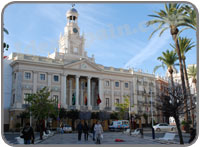
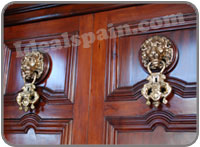
|
|
An
important
archway
is next.
The
Arco
de los
Blancos
was
once a
gateway
between
the
island
of
Cadiz
and
the
mainland.
As you
wander
along
the
tour,
admire
the
narrow
passageways
and
decorated
balconies
that
Cadiz
is
famous
for.
The historic part of Cadiz has hundreds of narrow streets, all worthy of exploration. |
| The Admiral's
House (Casa del Almirante) (pictured
right),
is
next
with
its
beautiful
marble
columns in the style of barley twist. The building is currently being reformed. Built in 1690, this palacial building was built by the family of the Admiral of the Spanish Treasure Fleet, with the proceeds of the trade with the Americas. The shield of the family appears on the second floor balcony. |
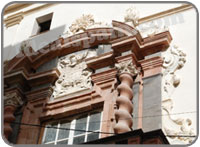
|
|
|
|
|
|
Head
towards
the
old
Cathedral
whose
dome
is
totally
unique
with
its
unusual
tiling. The new cathedral is nearby.
By far
the
most
impressive
building
in
Cadiz
has to
be the New
Cathedral
with
its
dome
and
huge
towers.
The
workmanship
all
around
the
Cathedral
is
amazing. |
|
|
|
| |
| The Roman
Theatre is
along
the
Paseo
Maritimo.
The
theatre
is
once
again
open
to the
public
after
extensive
work.
Work
continues
and a
new
visitor
centre
has just been constructed. Glass windows show the current excavations underway. |
|
The almost intact theatre was discovered after a warehouse fire in 1980. When the building had burned down, the Roman theatre was revealed beneath the rubble. Built in the 1st century, it is the second largest Roman theatre in the world. |
The Torre Poniente
This wonderful tower is part of the new cathedral and has recently been opened to the public. For 4 euros you can climb to the top of the tower where your hard work will be rewarded with the most amazing views over the city. The climb to the top of the tower takes around 10 minutes. It's a slope rather than steps which makes it easier and there are several rest stops. At the top of the tower you can see the bells that used to ring out over the city. The Torre Poniente is the tallest tower in Cadiz. You can see the climb on our Cadiz video. Hours of opening are 10am-8pm, June to September and 10am-6pm rest of year. Tel: 956 251 788. |
|
| |
|
Plaza Espana
One of our favorite plazas in Cadiz is the Plaza Espana. The monument that stands here remembers the constitution of Cadiz and is stunning. The plaza was built in the 20th century on land reclaimed from the sea. The main monument is to the Cadiz Parliament, Constitution and Siege. The monument was built to commemorate the La Pepa centenary in 1912. The plaza is surrounded by important buildings such as the merchants' houses with their characteristic watchtowers. |
The Tavira Tower
This tower, located in the historical centre of Cadiz is one of the top attractions in the city. The tower houses a camera obscura, the first one in Spain. This wonderful pieces of engineering allows for a perfect 360 degree view of the city by means of a pinhole camera. The image is then projected onto a special concave disc.. The experience includes a guide who will explain the images of the city. The guide lasts around 15 minutes and is held every 30 minutes. Each guide is limited to 15-20 people at a time. Within the same tower are several exhibition rooms. This tower was named the official watchtower of Cadiz in 1778 as it was the highest tower in the city, at 45 metres above sea level. At the time there were more than 160 watchtowers in the city. Local merchants used the towers to watch for arriving ships. Antonio Tavira was the head watchman at the time, in charge of watching the commercial ships coming and going from Cadiz.
|
The Tobacco Factory
This is located near the port and illustrates how Cadiz once had a busy trade in cigar manufacture. The factory no longer handles tobacco but houses an indoor exhibition centre. The building is similar to the tobacco factories in Malaga and Seville. The life-size, bronze statue (right) stands outside and shows two ladies making cigars.
Next door is the Convent of Santa Domingo |
|
| |
At each end of Caleta beach there is a castle, the Castle of San Sebastian and the Castle of Santa Catalina.
San Sebastian Castle is reached by means of a very long causeway. It is a military fort built in 1706. It is currently not being used.
Castle of Santa Catalina is also a military fort, built in 1598. It has been renovated and is now an exhibition centre.
|
|
A little further along the coastline is the largest of Cadiz' parks, the Parque Genoves. Caleta beach is where you find the working fishing fleet and the small leisure craft. The Paseo Maritimo here is dotted with pieces of modern sculpture and there's a lovely outdoor cafe overlooking the bay.
|
Cadiz can easily be divided into two major parts, the old and the new. The old part of Cadiz, described as the historical centre is where most tourists will want to be. You will find the architecture within this district to be of most interest. The newer part of Cadiz consists of a main avenue with hundreds of side streets. There are some great shopping areas to explore and some of the biggest hotels can be found here. The National Police station is also on the main avenue, just outside the city gates.
Museums in Cadiz
Museum has some fabulous museums including the Archaeological Museum, located near the city gates. Next to this museum is the Museum of Printing, (Museo Taller Litografico). The Museum of Cadiz is located in Plaza de Mina.
|
|
Getting around Cadiz is easy by several means. Taxis are plentiful and easy to spot. Driving around Cadiz is relatively easy but avoid the narrowest of backstreets. You will find parking limited regardless of the time of year. By far the easiest way to see Cadiz is by the open topped tour bus. The bus route consists of 12 stops conveniently placed near the popular monuments. You can hop on and off the bus all day long for just one ticket price of 15 euros and 7 euros for children. The bus ticket includes discount vouchers for some of the monuments such as the Tavira Tower so if you plan to visit these monuments then buy your bus ticket first. |
| The main transport links in Cadiz are located to the right of the old city, just after the city gates. You will find the main bus staion, the RENFE train station and the very busy port of Cadiz where ferries run to the Canary Islands. |
|
|
|
| |
The beaches in Cadiz
Without any doubt, one of the finest attractions in Cadiz are the beaches which consist of wide stretches of golden sand. The Playa de la Victoria is the longest of the beaches and is alongside modern Cadiz and the Playa de la Caleta is the smallest and can be found at the far tip of Cadiz, within the historical centre. The sand is soft and golden and the Atlantic has a tide. The beaches have facilities in the summer. |
|
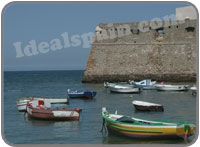
The tide is in at Playa de la Caleta
|
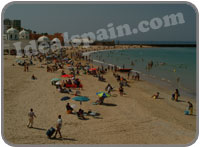
When the tide is out
|
Shopping in Cadiz
The historic part of Cadiz consists of straight and narrow streets lined with small shops. Many are artisan shops selling local hand made items. In between the shops are hundreds of small tapas bars and restaurants. Every now and again you stumble across a plaza. In the modern part of Cadiz, the main avenue has more modern and designer style shops. There are few large shops except El Corte Ingles.
Good buys include clothes, shoes and pottery. |
Accommodation in Cadiz
Hotels and hostels in Cadiz are easy to find. There are lots of small hostels, especially in the historic center. These range from around 30 euros per night. Whilst they provide comfortable accommodation at a good price, parking is rarely available. Outside of the historic centre you will find larger hotels ranging from 2-4 stars. Prices start at around 60 euros per night for double room. Many of the hotels have parking facilities, free wi-fi and have their own restaurants. Find hotels in Cadiz here. |
Our experiences in Cadiz
We have been to Cadiz several times, the latest visit being in December 2010. Arriving in Cadiz by car was trouble free. From the direction of Tarifa, the main road runs right into the city centre and the traffic was light and running smoothly. If you find yourself on the main avenue, as we did, a left hand turn towards the seafront is impossible so you have to go right to the roundabout at the end, then turn left. Parking is difficult most of the time and mostly on parking meters.
Despite being a large city, Cadiz was exceptionally clean. Wherever we went we received a warm and friendly welcome. The tourist office were very helpful and made our job easier. We saw most of Cadiz on foot and managed to find most of the monuments with the assistance of the tourist office maps. When it came to resting, we found food and drink to be very reasonably priced and of a high standard. Cafe and restaurant service was excellent. Our choice of hotel was controlled by the need for underground car parking so we opted for a hotel just outside the historic centre. The heart of the city was just 10 minutes on foot.
The botanical gardens and parks spread throughout the city offer wonderful places to sit and rest. The whole city is dotted with statues, monuments and more than 11 churches. Everywhere you go in Cadiz is pleasant, safe and exceptionally clean. |
| |
|
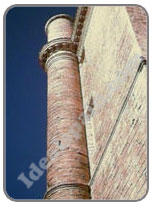 |
Inland
of
Cadiz
offers
a wide
variety
of
landscapes
and
tiny,
white-painted
villages,
well
worth
a
visit.
The
green
oasis
of
Grazalema
is
surrounded
by a
natural
park,
a
paradise
for
walkers
and
naturists.
To the
south,
rolling
hills
are
covered
with
walnut
trees,
pines
and
Spanish
firs.
Black
bulls
graze
beneath
cork
oaks.
Not
far
away,
vines
take
over,
covering
thousands
of
acres
of
white,
chalk
soil,
completing
what
is
known
as the
'Sherry
Triangle',
an
imaginary
triangular
boundary
between Jerez de la Frontera, Puerto
de
Santa
Maria and Sanlucar de Barrameda. Here you will find the oldest vineyards in Europe. |
Cadiz
has
much
to
offer
the
visitor
including
the
vibrant
fiestas
where
Flamenco
shows
are
the
norm.
Cadiz
is a
city
that
knows
how to
enjoy
itself
and is
not
afraid
of
showing
it.
Its
annual
carnival
in
February
is
known
to be
the
best
and
the
wildest
in
Spain.
Cadiz
has a
very
relaxed,
secure
feeling.
It is
almost
impossible
to get
lost
here,
with
the
presence
of the
sea on both sides to guide you. Whichever direction you go, keep going and you will end up on the shore again. |
|

